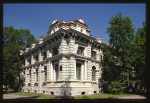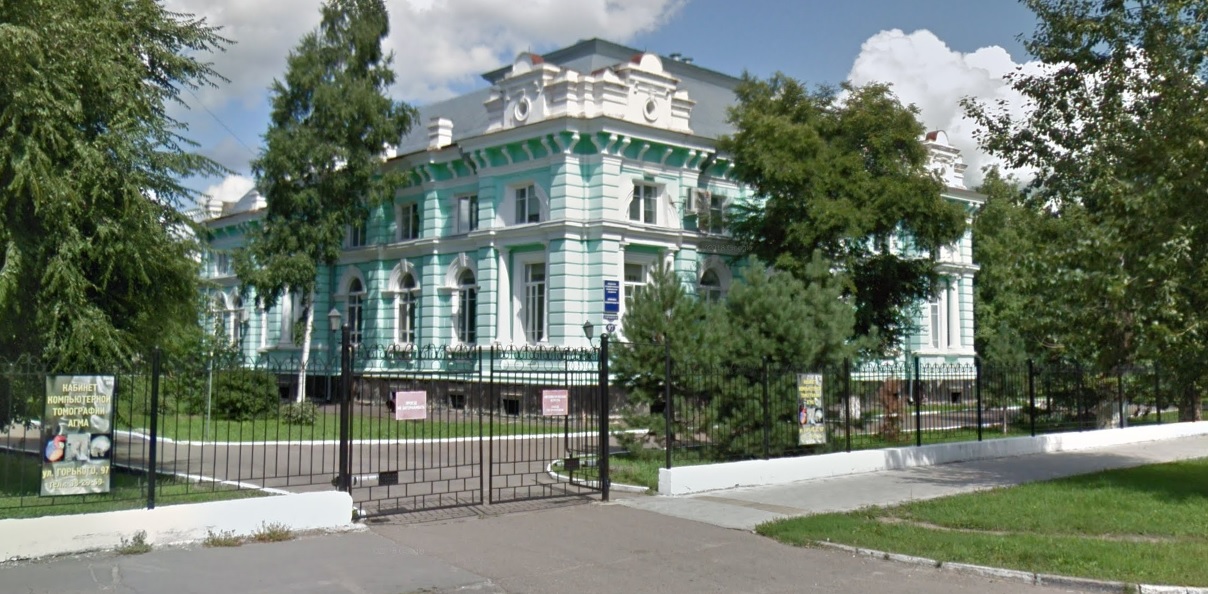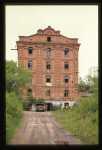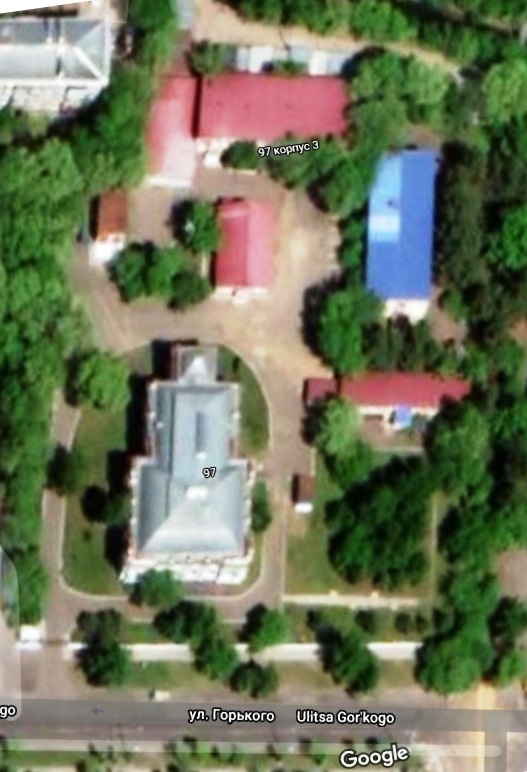
The William C. Brumfield
Photograph Collection:
From 1987-2000 William C. Brumfield took 1,137
photographic slides (color; 35mm.) for his research
and teaching as a Professor of Slavic Studies at Tulane
University, New Orleans, Louisiana, and as a lecturer at
the School of Architecture, museums, and universities in
North America and Europe.
Several hundred of the slides were taken especially for
the Library of Congress project "Meeting
of
Frontiers" on three trips to Russia in 1999 and
2000. The photographs document the architecture of
pre-Soviet Russia. Most of the structures are churches,
cathedrals, and monasteries, often shown in multiple
views. Structures are located in both large cities and
small towns from west of the Ural Mountains eastward
through Siberia. ... represented are dwellings,
commercial, and log buildings along with a few views of
meadows, lakes, rivers and trees.
|
Three of his
photos (below) in Blagoveshchensk
are definitely Molokan buildings — the church [prayer
house] and two businesses.
Details of Molokans in Amur, Far East Russia, can be found
in History of
Religious Sectarianism in Russia (1860s - 1917), by
A.I. Klibanov, (translated) pages 184-199, 205, with
statistics in the Appendix, pages 412-421. Here is an
excerpt:
"...precisely in the Amur
region, Molokanism found the freest conditions ... for
the structuring of their life on the basis of the faith,
traditions, and social and ethnical basis to which they
adhered. The resettlement of Molokans in the Amur region
began in 1859 ...Molokans and Doukhobors up to the 1880s
were half of the rural population of the Amur
region... in 1887..'. it would not be an exaggeration to
call the city of Blogoveshshensk
a Molokan city' . ... [they] conduct large
trading operations in meat and grain, which
unfortunately are monopolized exclusively by them. ...
from which operations they make large profits. ... 'the Molokans are the
wealthiest class.' ... A special study of
private property in land in Amur Oblast, conducted in
1910 ...showed that the proportion of Molokans among
landowners was ...about 68%.."
|

Photo
by
Brumfield
The right side of the building above (covered by
trees) is shown in the painting below, and the
left side
(covered by trees) is shown in the 2 photos far right.

Painting by
contemporary Blagoveshchensk
artist
Urii Nakonechnyi
|
Prayer
House of the Spiritual Christians
(Molokane) (built ~1910)
This is the largest Molokan prayer house,
church or building, in the world.
Inside are many support pillars. Capacity
is over 1000, the choir was in the 100s.
We don't know what happened to this
largest Molokan congregation in the world.
I'm not sure the building is still used
for religion. In the Summer of 1999 an
anthropologist from Washington state said
she entered the building and saw that
Baptists were worshiping, and a small
original sign at the entrance identified
the builders: "Молитвенный дом духовных
христин — молокан" ["Prayer house of the
Spiritual Christian Molokans"]. But a list of
historic buildings in Blagoveshchensk
says it is a "Perfusiology Laboratory
(artificial blood circulation), formerly a
Molokan sectarian prayer building" [#55.
Лаборатория искусственного
кровообращения (бывший молитвенный дом
молокан -сектантов)], address: 97
Gorky
Street (ул.
им.
Горького,
97). Maps of the region and city
below mark the prayer home location which
can be seen in detail by clicking on the
addresses above, or here
to
see the satellite image of the Moloan
prayer home.
Molokans in San Fransicso have 2 more
photos taken in the 1920s of the outside
and inside, which will be posted if
I get images.
|

Molokans
going to Sunday prayer meeting ~1910.
From: Blagoveshchensk
architecture

1912 postcard
titled: Molokan
prayer building — Blagoveshchensk.
|
|

The former Molokan meeting hall today. Google
Street View.
1919 visit to Molokan Church
A representatives of the Young Men's
Christian Association (YMCA) toured the Russian
Far East in 1919 to study the Orthodox Church..
He stopped in Tomsk, Omsk, Novo-Nikolaevsk,
Taiga, Krasnoiarsk, Irkutsk, Vladivostok,
Nikolsk-Ussurisk, Habarovsk, Old
Believers, Blagovestchensk (Molokane), Harbin
(Manchuria), Pekin (China), Seoul (Korea). Here
is his visit to the Molokan Prayer Home in
Blagoveshchensk
September 13th [1919] proved a very busy day—a
trip to China and a call on the collector of
customs; a call on a sick Old Believers’ priest; a
visit to his church; a visit to the Russian
Orthodox Seminary; an inspection of the incomplete
cathedral ; a trip to the Molokan Church;
and lastly, a long conversation with the pastor of
the local Baptist congregation.
(Visits Old Believer seminary)
... From the seminary a good view of the Molokan
Church may be obtained. The sect of the Molokans,
dairy-eaters Milk-drinkers
as they are sometimes called, is exceedingly
prosperous in the Blagovestchensk area. Members of
this sect own many of the largest buildings in
town, control the steamboat lines, and engage in
many important lines of business. Of course, I
could not neglect this opportunity of visiting
their church, which is a substantial structure
without excessive ornamentation, capable of
holding several hundred, and resembled somewhat a
Carnegie library building. Inside, it was
perfectly plain, with a pulpit or reading desk at
one end and chairs and pews for the worshippers. I
had no opportunity of attending any of the
services. On this day, Saturday, several of the
members were about the church engaged in
preparations for Sunday, and from them I was able
to gather information that perhaps I would not
have gained from a formal interview with the
church officials. When I asked if they had any
ikons, they vehemently asserted that they never
allowed such things in their church buildings.
They evidently are whole-hearted protestants from
the position of the Russian Orthodox Church.
Before the Association undertakes a work in
Blagovestchensk, it will be necessary to study
this interesting sect and to plan an approach
accordingly.
At the Molokan church, I was told of a
minister who would be very glad to talk with me on
religious questions. I, therefore, called upon him
with the idea that he was one of their ministers,
and at once began to question him as to the
particular tenets of the sect. He answered my
questions carefully and stated the Molokan position
with a frankness that at times actually embodied
stern criticism, incompatible with the beliefs of
a Molokan. For the first time my
suspicions were aroused, and I said to him, “How
can you hold such beliefs and criticize them so
calmly?” He replied with a smile of understanding,
“I am the Baptist minister here, not a Molokan.”
This Baptist minister spoke English accurately,
and it was a real pleasure to get his estimate of
local religious conditions. He was deeply versed
in theology and could express himself with a
clearness that was refreshing. It seemed to me a
good opportunity to get his valuation of the
Russian Orthodox Church and also the local sects.
Out of curiosity, I asked him to state the
Anglican position as he understood it, and,
judging from the keen analysis and just balance
which he preserved in presenting my own church
position, I have every reason to suppose that he
stated the Orthodox and other beliefs with a like
accuracy.
He spoke of his own denomination, the Baptists,
and gave me some insight into their problems. I
spoke of the Association, but explanations in the
face of his wide knowledge of us, were not
necessary. It would be interesting to speak of the
Baptists and other sects which have been created
under the influence of Protestantism in the West,
but we must hark back to this report. In passing,
however, I might say that imported religious
bodies have heretofore been unable to compete with
Russian sects, to say nothing of the Russian
Orthodox Church.
Young
Men's Christian Association and the Orthodox
Church, by Fredric Charles Meredith, 1921,
pages 42-44.
|
 |
Saiapin Brothers
Flour Mill (built ~1899)
"During the 1880s and especially the 1890s in the
cities of the Amur region , industrial production
developed — flour milling, lumbering, and the
cheese-capitalists. The Molokans Alekseev,
Voblikov, and Saiapin
had a flour-milling business, whose
equipment cost 132,000 rubles, and their yearly
production in 1896 amounted to 643,030 rubles." [Nearly 500%
return on investment (ROI) per year !] (Klibanov,
page 185). Only one Molokan from Amur
attended the 2nd International Molokan Convention
in Ukriane in 1992 — Saiapin.
|
|

|
Kositsyn
Store (built ~1902)
After the Russian Revolution, some Kositsyns from
Blagoveshchensk fled from Russia through China.
They lived in Harbin (see map above) for several
years with hundreds of other refugees, many were
Molokans and Doukhobors. These Kositsyns then
moved to Sidney, Australia, where they established
a Molokan church in the 1950s. One Kositsyn was
presbyter, and his brother (Leo Nick. Kocitzen)
later moved to Oakland, California, and joined the
San Francisco Molokan church. In the 1960s Leo was
the first American Molokan to meet Dr.
Stephen P. Dunn and Ethel Dunn and introduce
them to other Molokans. At that time the Dunns
just started to translate articles about Russian
Molokans, they later published several books and
many articles about American Molokans and
Jumper/Maksimists.
|
|
|








